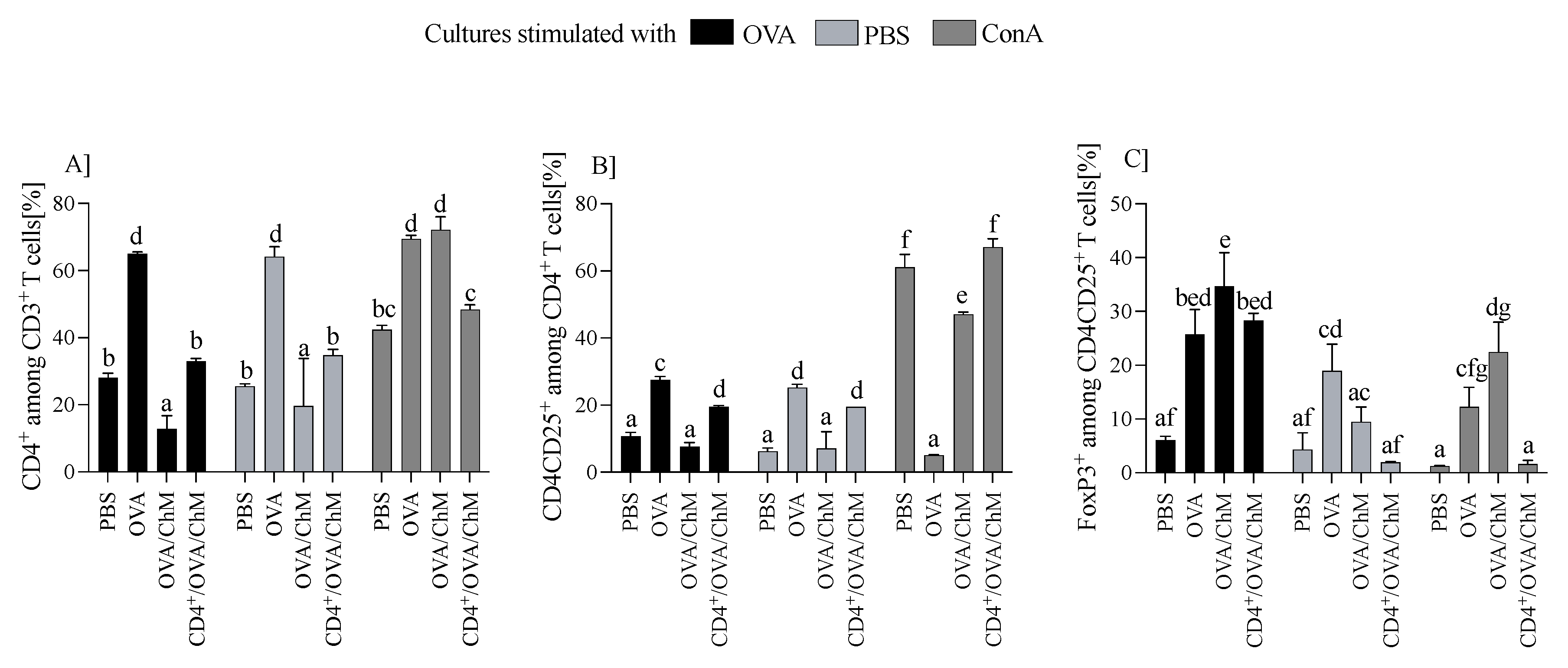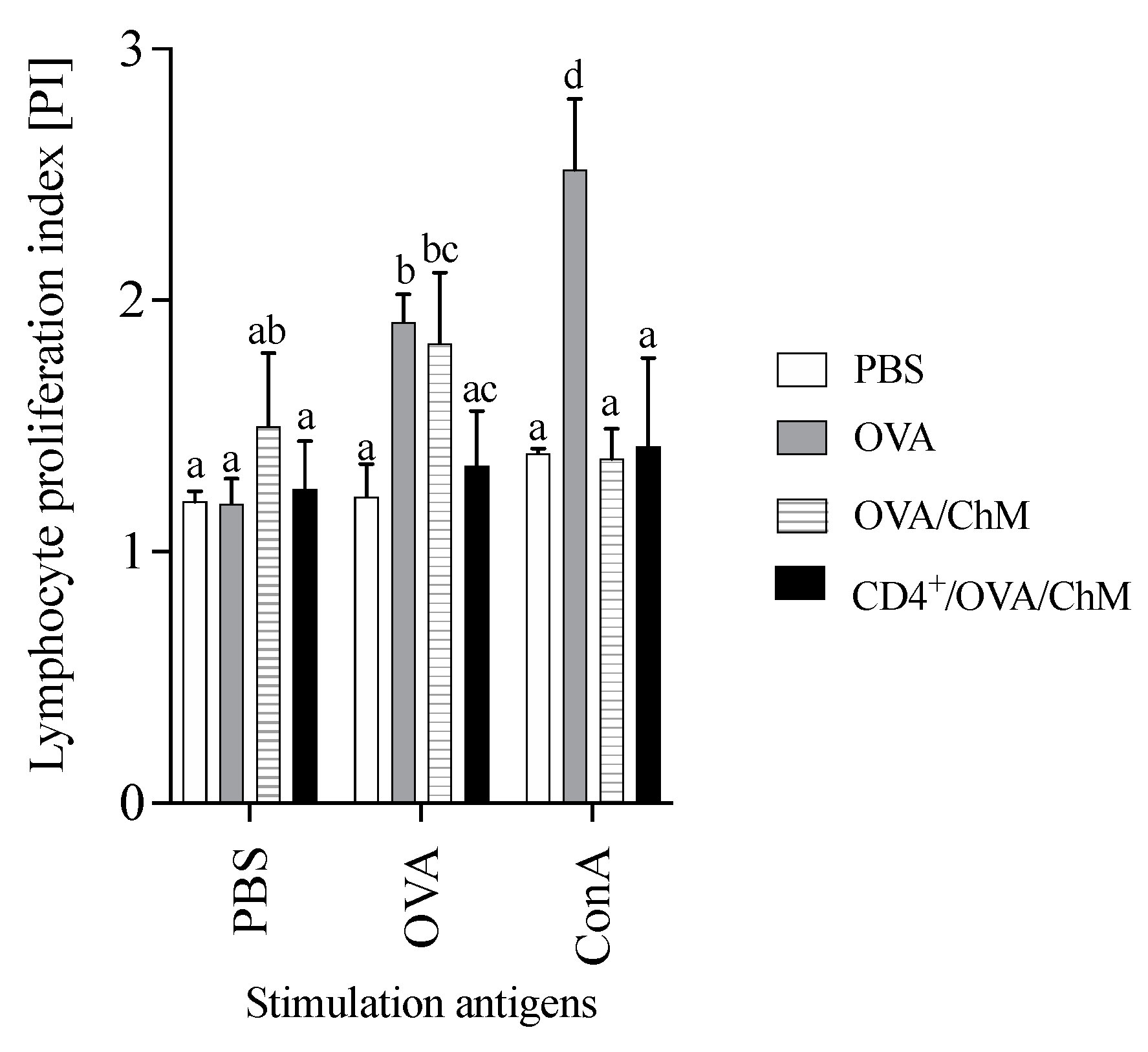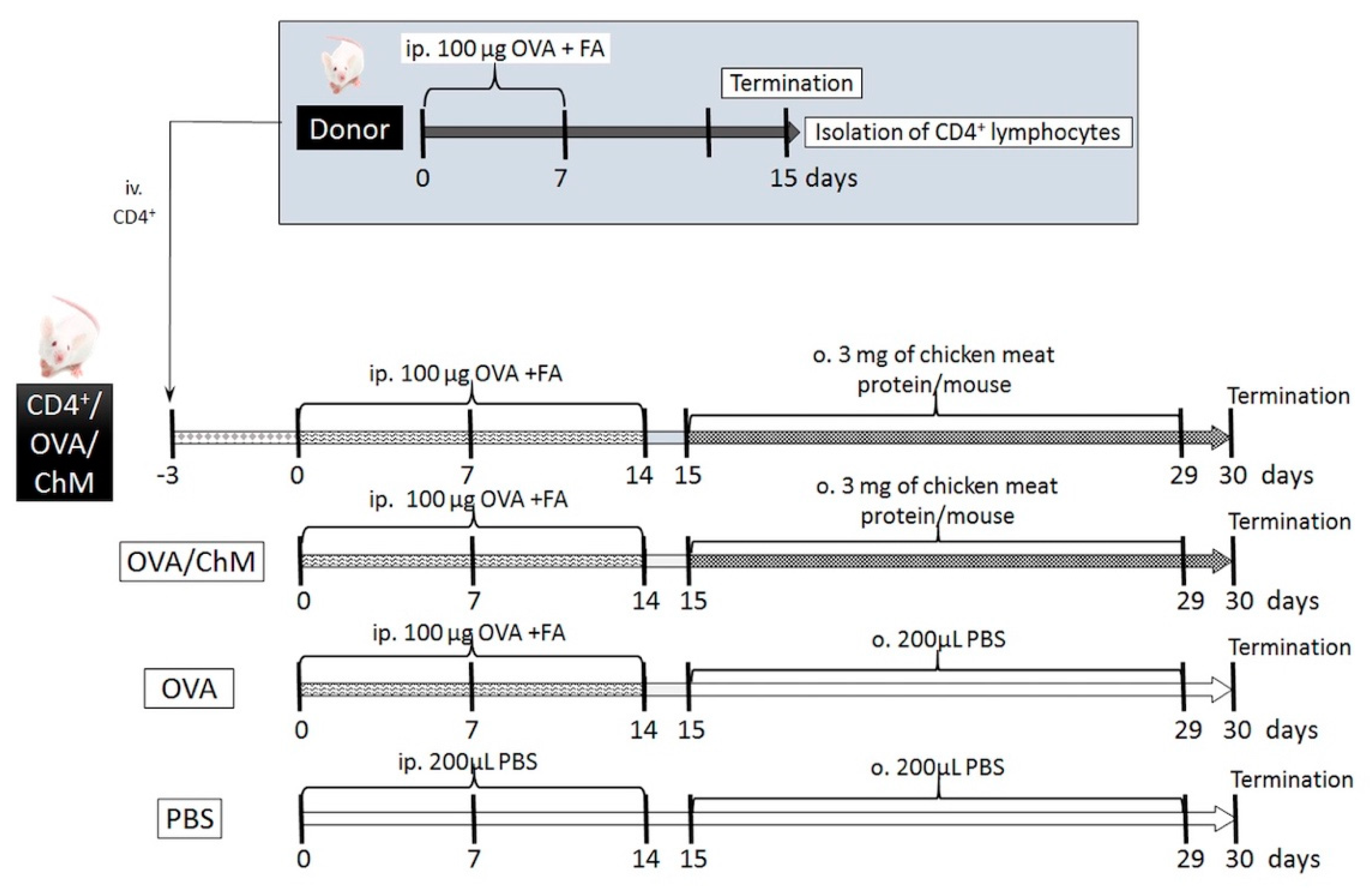OVA-Experienced CD4+ T Cell Transfer and Chicken Protein Challenge Affect the Immune Response to OVA in a Murine Model
Abstract
:1. Introduction
2. Results
2.1. Adoptively Transferred OVA-Sensitized CD4+ T Cells Affect the Mouse Humoral Response
2.2. Changes in CD3+CD4+, CD3+CD4+CD25+, and Foxp3+ Populations Induced by the Tested Proteins
2.3. Adoptive Transfer of the CD4+ T Cells Altered Lymphocyte Proliferation Capacity
2.4. Changes in Cytokine Secretion Following CD4+ T Cell Transfer
3. Discussion
4. Materials and Methods
4.1. Animals
4.2. Protein and Chicken Meat Used for Mouse Treatment
4.3. Experimental Design
- CD4+/OVA/ChM group—received intravenous (iv.) transfer of OVA-experienced CD4+ T cells, then the mice were injected intraperitoneally (ip.) with OVA and gavaged with freeze-dried chicken meat solution;
- OVA/ChM group—mice were injected ip. with OVA and gavaged with freeze-dried chicken meat;
- OVA group—injected ip. with OVA;
- PBS group—injected ip. and gavaged with PBS.
4.3.1. Generating OVA-Experienced CD4+ T Cells for Transfer
4.3.2. Animal Sensitization with OVA and Challenge with Chicken Meat
4.4. Lymphocyte Isolation and Culture
4.5. Phenotyping Lymphocytes
4.6. Cytokine Determination
4.7. Lymphocyte Proliferation Index (PI)
4.8. Measurement of Total IgE Concentration and Anti-OVA IgA and IgG Titers
4.9. Statistical Analysis
Author Contributions
Funding
Institutional Review Board Statement
Informed Consent Statement
Data Availability Statement
Conflicts of Interest
References
- Martorell, A.; Alonso, E.; Boné, J.; Echeverría, L.; López, M.C.; Martín, F.; Nevot, S.; Plaza, A.M. Food allergy committee of SEICAP (Spanish Society of Pediatric Allergy, Asthma and Clinical Immunology). Position document: IgE-mediated allergy to egg protein. Allergol. Immunopathol. 2013, 41, 320–336. [Google Scholar] [CrossRef]
- Langeland, T.A. A clinical and immunological study of allergy to hen’s egg white. VI. Occurrence of proteins cross-reacting with allergens in hen’s egg white as studied in egg white from turkey, duck, goose, seagull, and in hen egg yolk, and hen and chicken sera and flesh. Allergy 1983, 38, 399–412. [Google Scholar] [CrossRef] [PubMed]
- Caubet, J.C.; Wang, J. Current Understanding of Egg Allergy. Pediatr. Clin. N. Am. 2011, 58, 427–443. [Google Scholar] [CrossRef] [Green Version]
- Besler, M.; Fiocchi, A.; Restani, P. Allergen Data Collection: Chicken Meat (Gallus domesticus). Internet Symp. Food Allerg. 2001, 3, 193–201. [Google Scholar]
- Hemmer, W.; Klug, C.; Swoboda, I. Update on the bird-egg syndrome and genuine poultry meat allergy. Allergo J. Int. 2016, 25, 68–75. [Google Scholar] [CrossRef] [Green Version]
- Theler, B.; Brockowb, K.; Duttaa, M.; Ballmer-Weber, B.K. Clinical presentation, and diagnosis of meat allergy in Switzerland and Southern Germany. Swiss Med. Wkly. 2009, 139, 264–270. [Google Scholar]
- Zacharisen, M.C. Severe allergy to chicken meat. Wis. Med. J. 2006, 105, 50–52. [Google Scholar]
- Liccardi, G.; Szepfalusi, Z.; Noschese, P.; Nentwich, I.; D’amato, M.; D’amato, G. Allergy to chicken meat without sensitization to egg proteins: A case report. J. Allergy Clin. Immunol. 1997, 100, 577–579. [Google Scholar] [CrossRef]
- Klug, C.; Hemmer, W.; Román-Carrasco, P.; Focke-Tejkl, M.; Quirce, S.; Boyano-Martínez, T.; Gaubitzer, E.; Wank, H.; Swoboda, I. Gal d 7—A Major Allergen in Primary Chicken Meat Allergy. J. Allergy Clin. Immunol. 2020, 146, 169–179.e5. [Google Scholar] [CrossRef]
- Bartuzi, Z.; Kaczmarski, M.; Czerwionka-Szaflarska, M.; Malaczynska, T.; Krogulska, A. The diagnosis and management of food allergies. Position paper of the Food Allergy Section the Polish Society of Allergology. Postep. Derm. Alergol. 2017, 34, 391–404. [Google Scholar]
- Marangoni, F.; Corsello, G.; Cricelli, C.; Ferrara, N.; Ghiselli, A.; Lucchin, L.; Poli, A. Role of poultry meat in a balanced diet aimed at maintaining health and wellbeing: An Italian consensus document. Food Nutr. Res. 2015, 59, 27606. [Google Scholar] [CrossRef] [PubMed] [Green Version]
- Smaldini, P.L.; Delgado, M.L.O.; Fossati, C.A.; Docena, G.H. Orally induced intestinal CD4+ CD25+ FoxP3+ Treg controlled undesired responses towards oral antigens and effectively dampened food allergic reactions. PLoS ONE 2015, 10, e0141116. [Google Scholar] [CrossRef] [PubMed] [Green Version]
- Haczku, A.; Macary, P.; Huang, T.-J.; Tsukagoshi, H.; Barnes, P.J.; Kay, A.B.; Kemeny, D.M.; Chung, K.F.; Moqbel, R. Adoptive transfer of allergen-specific CD4+ T cells induces airway inflammation and hyperresponsiveness in Brown-Norway rats. Immunology 1997, 91, 176–185. [Google Scholar] [CrossRef]
- Yamashita, H.; Takahashi, K.; Tanaka, H.; Nagai, H.; Inagaki, N. Overcoming food allergy through acquired tolerance conferred by transfer of Tregs in a murine model. Allergy 2012, 67, 201–209. [Google Scholar] [CrossRef]
- Wang, K.; Zhu, T.; Wang, H.; Yang, J.; Du, S.; Dong, G.; Pei, Z.; Hu, G. Adoptive Transfers of CD4+CD25+ Tregs Raise Foxp3 Expression and Alleviate Mouse Enteritis. BioMed Res. Int. 2018, 2018, 9064073. [Google Scholar] [CrossRef]
- González-Mancebo, E.; Pastor, C.; González-de-Olano, D.; Gandolfo-Cano, M.; Melendez, A.; Cuesta, J.; Zapatero, A.; Bartolomé, B. Identification of Allergens in Chicken Meat Allergy. J. Investig. Allergol. Clin. Immunol. 2011, 21, 326–327. [Google Scholar]
- Romagnani, S. Immunologic influences on allergy and the Th1/Th2 balance. J. Allergy Clin. Immunol. 2004, 113, 395–400. [Google Scholar] [CrossRef] [PubMed]
- Berger, A. Science commentary: Th1 and Th2 responses: What are they? Br. Med. J. 2000, 321, 424. [Google Scholar] [CrossRef] [Green Version]
- Rosenberg, S.A.; Restifo, N.P.; Yang, J.C.; Morgan, R.A.; Dudley, M.E. Adoptive cell transfer: A clinical path to effective cancer immunotherapy. Nat. Rev. Cancer 2008, 8, 299–308. [Google Scholar] [CrossRef]
- Ben-Ami, E.; Schachter, J. Adoptive transfer of tumor-infiltrating lymphocytes for melanoma: New players, old game. Immunotherapy 2015, 7, 477–479. [Google Scholar] [CrossRef]
- Wise, J.T.; Baginski, T.J.; Mobley, J.L. An Adoptive Transfer Model of Allergic Lung Inflammation in Mice Is Mediated by CD4+CD62LlowCD25+ T Cells. J. Immunol. 1999, 162, 5592–5600. [Google Scholar]
- Xu, W.; Lan, Q.; Chen, M.; Chen, H.; Zhu, N.; Zhou, X.; Wang, J.; Fan, H.; Yan, C.S.; Kuang, J.L.; et al. Adoptive transfer of induced-Treg cells effectively attenuates murine airway allergic inflammation. PLoS ONE 2012, 7, e40314. [Google Scholar] [CrossRef] [PubMed]
- Eigenmann, P.A.; Sicherer, S.H.; Borkowski, T.A.; Cohen, B.A.; Sampson, H.A. Prevalence of IgE-mediated food allergy among children with atopic dermatitis. Pediatrics 1998, 101, e8. [Google Scholar] [CrossRef] [PubMed] [Green Version]
- Chang, M.-L.; Cui, C.; Liu, Y.-H.; Pei, L.-C.; Shao, B. Analysis of total immunoglobulin E and specific immunoglobulin E of 3721 patients with allergic disease. Biomed. Rep. 2015, 3, 573–577. [Google Scholar] [CrossRef] [Green Version]
- Saldanha, J.C.S.; Gargiulo, D.L.; Silva, S.S.; Carmo-Pinto, F.H.; Andrade, M.C.; Alvarez-Leite, J.I.; Teixeira, M.M.; Cara, D.C. A model of chronic IgE-mediated food allergy in ovalbumin-sensitized mice. Braz. J. Med. Biol. Res. 2004, 37, 809–816. [Google Scholar] [CrossRef] [PubMed]
- Ozdemir, C.; Akdis, M.; Akdis, C.A. T-Cell response to allergens. Chem. Immunol. Allergy 2010, 95, 22–44. [Google Scholar]
- Agua-Doce, A.; Graca, L. Regulatory T Cells and the Control of the Allergic Response. J. Allergy 2012, 2012, 948901. [Google Scholar] [CrossRef] [Green Version]
- Hoffman, K.M.; Ho, D.G.; Sampson, H.A. Evaluation of the usefulness of lymphocyte proliferation assays in the diagnosis of allergy to cow’s milk. J. Allergy Clin. Immunol. 1997, 99, 360–366. [Google Scholar] [CrossRef]
- Deo, S.S.; Mistry, K.J.; Kakade, A.M.; Niphadkar, P.V. Role played by Th2 type cytokines in IgE mediated allergy and asthma. Lung India 2010, 27, 66–71. [Google Scholar] [CrossRef]
- Ngoc, L.P.; Gold, D.R.; Tzianabos, A.O.; Weiss, S.T.; Celedón, J.C. Cytokines, allergy, and asthma. Curr. Opin. Allergy Clin. Immunol. 2005, 5, 161–166. [Google Scholar] [CrossRef]
- Wróblewska, B.; Kaliszewska-Suchodoła, A.; Fuc, E.; Markiewicz, L.H.; Ogrodowczyk, A.M.; Złotkowska, D.; Wasilewska, E. Effect of Low-Immunogenic Yogurt Drinks and Probiotic Bacteria on Immunoreactivity of Cow’s Milk Proteins and Tolerance Induction—In Vitro and In Vivo Studies. Nutrients 2020, 12, 3390. [Google Scholar] [CrossRef]
- Toyoshima, S.; Wakamatsu, E.; Ishida, Y.; Obata, Y.; Kurashima, Y.; Kiyono, H.; Abe, R. The spleen is the site where mast cells are induced in the development of food allergy. Int. Immunol. 2017, 29, 31–45. [Google Scholar] [CrossRef] [Green Version]
- Gaudino, S.J.; Kumar, P. Crosstalk between antigen presenting cells and T cells impacts intestinal homeostasis, bacterial infections, and tumorigenesis. Front. Immunol. 2019, 10, 360. [Google Scholar] [CrossRef] [Green Version]
- Teixeira, L.K.; Fonseca, B.P.F.; Barboza, B.A.; Viola, J.P.B. The role of interferon-gamma on immune and allergic responses. Mem. Inst. Oswaldo Cruz 2005, 100 (Suppl. S1), 137–144. [Google Scholar] [CrossRef] [Green Version]
- Jurado, A.; Carballido, J.; Griffel, H.; Hochkeppel, H.K.; Wetzel, G.D. The immunomodulatory effects of interferon-gamma on mature B-lymphocyte responses. Experientia 1989, 45, 521–526. [Google Scholar] [CrossRef] [PubMed]
- Yu, H.; Cui, S.; Mei, Y.; Li, Q.; Wu, L.; Duan, S.; Cai, G.; Zhu, H.; Fu, B.; Zhang, L.; et al. Mesangial Cells Exhibit Features of Antigen-Presenting Cells and Activate CD4+ T Cell Responses. J. Immunol. Res. 2019, 2019, 2121849. [Google Scholar] [CrossRef]
- Marconi, M.; Plebani, A.; Avanzini, M.A.; Maccario, R.; Pistorio, A.; Duse, M.; Stringa, M.; Monafo, V. IL-10 and IL-4 co-operate to normalize in vitro IgA production in IgA- deficient (IgAD) patients. Clin. Exp. Immunol. 1998, 112, 528–532. [Google Scholar] [CrossRef] [PubMed]
- Kara, M.; Beser, O.F.; Konukoglu, D.; Cokugras, H.; Erkan, T.; Kutlu, T.; Cokugras, F.C. The utility of TNF-α, IL-6 and IL-10 in the diagnosis and/or follow-up food allergy. Allergol. Immunopathol. 2020, 48, 48–55. [Google Scholar] [CrossRef]
- Dienz, O.; Eaton, S.M.; Rey, J.; Bond, P.; Neveu, W.; Moquin, D.; Noubade, R.; Briso, E.M.; Charland, C.; Leonard, W.J.; et al. The induction of antibody production by IL-6 is indirectly mediated by IL-21 produced by CD4+ T cells. J. Exp. Med 2009, 206, 69–78. [Google Scholar] [CrossRef] [PubMed]
- Rhee, K.C. Determination of Total Nitrogen. Curr. Protoc. Food Anal. Chem. 2001, B1.2.1–B1.2.9. [Google Scholar] [CrossRef]
- Lynch, J.M.; Barbano, D.M. Kjeldahl nitrogen analysis as a reference method for protein determination in dairy products. J. AOAC Int. 1999, 82, 1389–1398. [Google Scholar] [CrossRef] [Green Version]
- Chudzik-Kozłowska, J.; Wasilewska, E.; Złotkowska, D. Evaluation of Immunoreactivity of Pea (Pisum sativum) Albumins in BALB/c and C57BL/6 Mice. J. Agric. Food Chem. 2020, 68, 3891–3902. [Google Scholar] [CrossRef] [PubMed]
- Fuc, E.; Złotkowska, D.; Wróblewska, B. Milk and Meat Allergens from Bos taurus β-Lactoglobulin, α-Casein, and Bovine Serum Albumin: An In-Vivo Study of the Immune Response in Mice. Nutrients 2019, 11, 2095. [Google Scholar] [CrossRef] [PubMed] [Green Version]
- Wasilewska, E.; Zlotkowska, D.; Wroblewska, B. Yogurt starter cultures of Streptococcus thermophilus and Lactobacillus bulgaricus ameliorate symptoms and modulate the immune response in a mouse model of dextran sulfate sodium-induced colitis. J. Dairy Sci. 2019, 102, 37–53. [Google Scholar] [CrossRef] [PubMed] [Green Version]
- Mierzejewska, D.; Mitrowska, P.; Rudnicka, B.; Kubicka, E.; Kostyra, H. Effect of non-enzymatic glycosylation of pea albumins on their immunoreactive properties. Food Chem. 2008, 111, 127–131. [Google Scholar] [CrossRef]





Publisher’s Note: MDPI stays neutral with regard to jurisdictional claims in published maps and institutional affiliations. |
© 2021 by the authors. Licensee MDPI, Basel, Switzerland. This article is an open access article distributed under the terms and conditions of the Creative Commons Attribution (CC BY) license (https://creativecommons.org/licenses/by/4.0/).
Share and Cite
Fuc, E.; Złotkowska, D.; Wasilewska, E.; Wróblewska, B. OVA-Experienced CD4+ T Cell Transfer and Chicken Protein Challenge Affect the Immune Response to OVA in a Murine Model. Int. J. Mol. Sci. 2021, 22, 6573. https://doi.org/10.3390/ijms22126573
Fuc E, Złotkowska D, Wasilewska E, Wróblewska B. OVA-Experienced CD4+ T Cell Transfer and Chicken Protein Challenge Affect the Immune Response to OVA in a Murine Model. International Journal of Molecular Sciences. 2021; 22(12):6573. https://doi.org/10.3390/ijms22126573
Chicago/Turabian StyleFuc, Ewa, Dagmara Złotkowska, Ewa Wasilewska, and Barbara Wróblewska. 2021. "OVA-Experienced CD4+ T Cell Transfer and Chicken Protein Challenge Affect the Immune Response to OVA in a Murine Model" International Journal of Molecular Sciences 22, no. 12: 6573. https://doi.org/10.3390/ijms22126573





